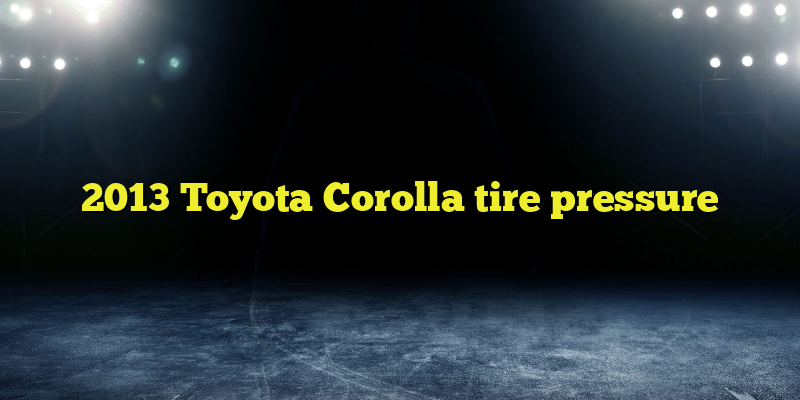Maintaining the correct tire pressure in your 2013 Toyota Corolla is essential for optimal performance, safety, and fuel efficiency. In this article, we will discuss the importance of tire pressure, how to check and adjust it, and provide answers to frequently asked questions about tire pressure in the 2013 Toyota Corolla.
Why is Tire Pressure Important?
Proper tire pressure is crucial for several reasons. First, it ensures that the tires have sufficient grip on the road, allowing for safe and predictable handling. Incorrect tire pressure can lead to reduced traction, increased braking distances, and compromised stability. Second, maintaining the recommended tire pressure helps to extend the lifespan of your tires by promoting even wear. Lastly, correct tire pressure contributes to better fuel efficiency. Underinflated tires create more rolling resistance, resulting in increased fuel consumption.
How to Check Tire Pressure
Checking the tire pressure in your 2013 Toyota Corolla is a simple process that can be done at home or at a gas station. Here are the steps to follow:
- Ensure that your vehicle is parked on a level surface and the tires are cool.
- Locate the tire pressure placard, typically located on the driver’s side door jamb or inside the fuel filler flap. This placard displays the recommended tire pressure for your vehicle.
- Remove the valve cap from the tire you wish to check.
- Attach a tire pressure gauge to the valve stem and press firmly until the hissing sound stops. The tire pressure gauge will display the current pressure.
- Compare the measured pressure to the recommended pressure on the placard. If the measured pressure is lower, add air until it reaches the recommended level. If it is higher, release air until it matches the recommended pressure.
- Repeat the process for each tire, including the spare tire.
When to Check Tire Pressure
It is recommended to check your tire pressure at least once a month and before long trips. Changes in temperature can affect tire pressure, so it’s important to monitor it regularly. Additionally, if you notice any signs of uneven tire wear, such as excessive wear on the edges or in the center of the tire, it may indicate an issue with tire pressure or alignment and should be checked immediately.
Recommended Tire Pressure for the 2013 Toyota Corolla
The recommended tire pressure for the 2013 Toyota Corolla may vary depending on the trim level and tire size. It is important to refer to the tire pressure placard for the specific values. As a general guideline, the recommended tire pressure for the 2013 Toyota Corolla is typically around 32 PSI (pounds per square inch) for the front tires and 29 PSI for the rear tires.
2013 Toyota Corolla Tire Pressure FAQ
1. How often should I check my tire pressure?
It is recommended to check your tire pressure at least once a month and before long trips. Changes in temperature can affect tire pressure, so it’s important to monitor it regularly.
2. What is the recommended tire pressure for the 2013 Toyota Corolla?
The recommended tire pressure for the 2013 Toyota Corolla may vary depending on the trim level and tire size. It is important to refer to the tire pressure placard for the specific values. As a general guideline, the recommended tire pressure for the 2013 Toyota Corolla is typically around 32 PSI for the front tires and 29 PSI for the rear tires.
3. Can I use the tire pressure listed on the tire sidewall?
The tire pressure listed on the tire sidewall is the maximum pressure that the tire can handle, not the recommended pressure for your vehicle. Always follow the recommended tire pressure specified by the manufacturer for optimal performance and safety.
4. What are the consequences of driving with underinflated or overinflated tires?
Driving with underinflated or overinflated tires can have several consequences. Underinflated tires can lead to reduced traction, increased braking distances, and compromised stability. They also tend to wear out faster and can cause poor fuel efficiency. Overinflated tires can result in a harsh ride, reduced traction, and uneven tire wear in the center of the tread.
5. Can I rely on the tire pressure monitoring system (TPMS) in my 2013 Toyota Corolla?
While the tire pressure monitoring system (TPMS) in your 2013 Toyota Corolla can provide an indication of low tire pressure, it is still important to manually check the tire pressure regularly with a gauge. TPMS may not always detect gradual pressure loss or variations in tire pressure between the front and rear tires.
6. What should I do if my tire pressure is consistently low?
If you consistently find low tire pressure in your 2013 Toyota Corolla, it may indicate a puncture or leak in the tire. Inspect the tire for any visible damage or objects embedded in the tread. If you cannot find any issues, it is recommended to visit a professional tire service center for further inspection and repair.










